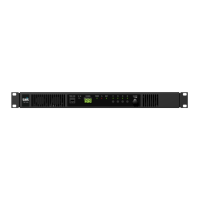TB7100 Service Manual Circuit Descriptions 41
© Tait Electronics Limited October 2005
4.1 Transmitter Circuitry
Introduction For a block diagram of the transmitter circuitry, refer to Figure 4.2.
The transmitter circuitry is different for the 50W/40W boards and the 25W
boards, and the different bands.
Exciter With the 50W/40W boards, the discrete-component exciter is designed for
specific bands (UHF or VHF). It is made up of Q3501, Q3502, and Q3505,
which amplify the signal provided by the frequency synthesizer from its level
of 7 to 10dBm up to 24dBm for the frequency bands 136 to 174MHz and
400 to 520MHz.
With the 25W boards, the broadband exciter is a common element in all
the bands, as it operates across all frequencies from 66 to 530MHz. It is made
up of Q300 and Q303, which amplify the signal provided by the frequency
synthesizer from its level of 7 to 10dBm up to 24.5dBm for the frequency
band from 66 to 530MHz.
The exciter operates in full saturation, thereby maintaining a constant
output power independent of the varying input power level supplied by the
synthesizer.
Power Amplifier The power amplifier comprises the driver amplifier Q306 and two paralleled
final devices Q309 and Q310.
With the 50W/40W boards, the signal from the exciter is amplified by
Q306 to a power level of approximately 2W (VHF) using a PD55003 and
about 3W (UHF) using a PD55008. The resulting signal is then amplified
by Q309 and Q310 to produce a typical output power of 90W at 155MHz
and 65W across the UHF band, when measured after the series capacitors
(C348, C349, C350) at the start of the directional coupler.
With the 25W boards, the 24.5dBm signal from the exciter is reduced by a
band-dependent pi-attenuator and is amplified by Q306. The resulting
signal is then amplified a second time by Q309 and Q310 to produce a
typical output power of 42W when measured after the series capacitors
(C348, C349, C350) at the start of the directional coupler.
The high-level RF signal passes via the directional coupler, the transmit-
receive PIN switch, and the LPF, through to the antenna. The LPF is used
to attenuate unwanted harmonic frequencies.
Power Control Loop Calibration is used to adjust the power control loop, thus setting the output
of the transmitter to one of four preferred power levels:
■ 10, 15, 25, and 50 watts (VHF), and
10, 15, 20, and 40 watts (UHF) for 50W/40W boards
■ 1, 5, 12 and 25 watts (all bands) for 25W boards

